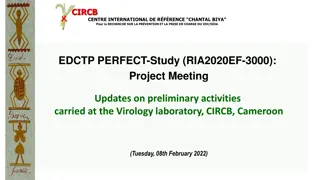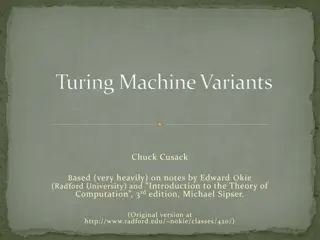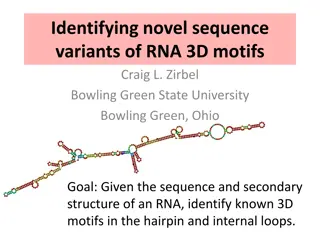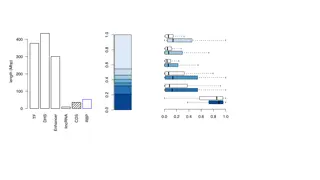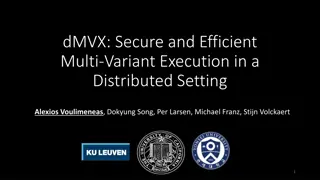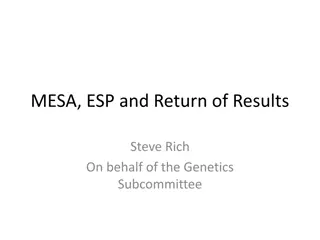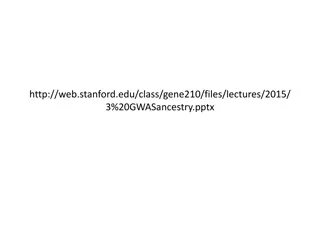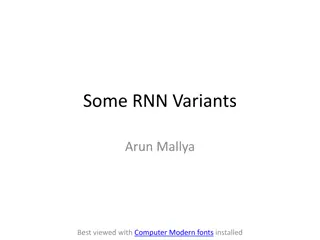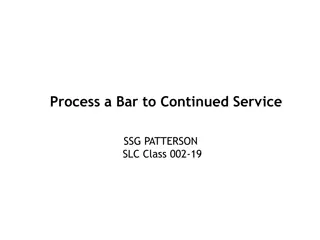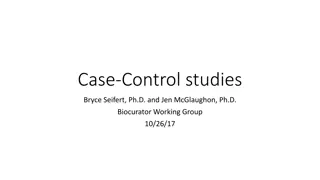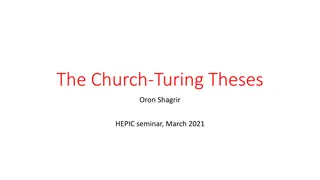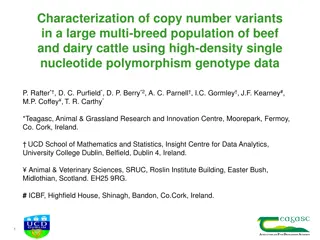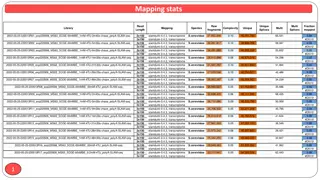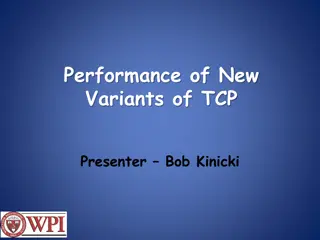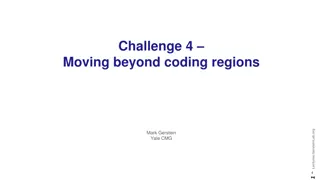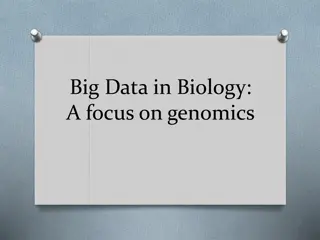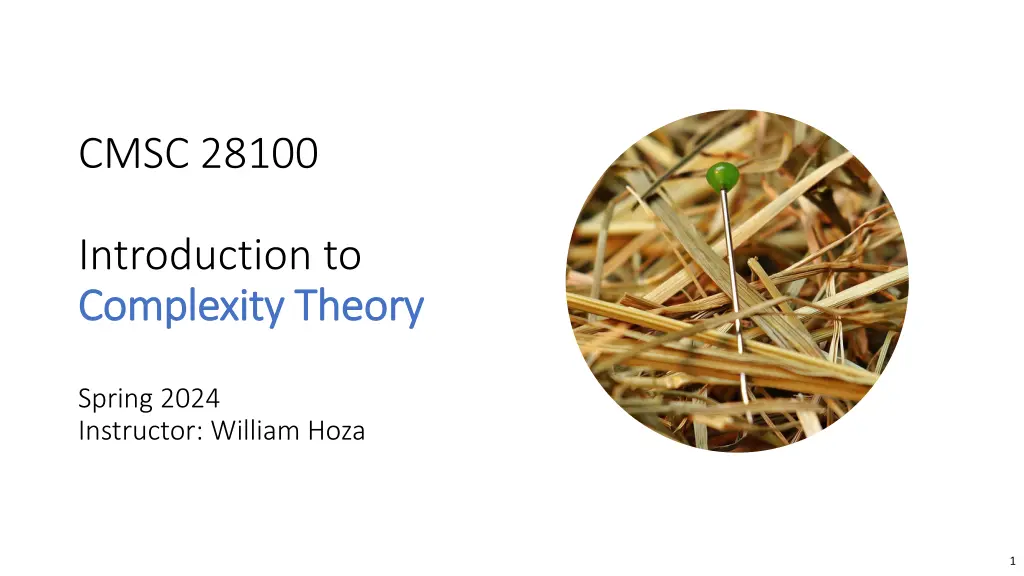
Introduction to Complexity Theory
Explore the fundamental concepts in complexity theory, including the Church-Turing Thesis, multi-tape Turing machines, and simulating multiple tapes with one tape. Dive into the implications of these theories for understanding computation and problem-solving processes. Instructor: William Hoza.
Download Presentation

Please find below an Image/Link to download the presentation.
The content on the website is provided AS IS for your information and personal use only. It may not be sold, licensed, or shared on other websites without obtaining consent from the author. If you encounter any issues during the download, it is possible that the publisher has removed the file from their server.
You are allowed to download the files provided on this website for personal or commercial use, subject to the condition that they are used lawfully. All files are the property of their respective owners.
The content on the website is provided AS IS for your information and personal use only. It may not be sold, licensed, or shared on other websites without obtaining consent from the author.
E N D
Presentation Transcript
CMSC 28100 Introduction to Complexity Theory Complexity Theory Spring 2024 Instructor: William Hoza 1
The Church-Turing Thesis Let ? be a language Church-Turing Thesis: There exists an algorithm / procedure for figuring Intuitive notion out whether a given string is in ? if and only if there Mathematically precise notion exists a Turing machine that decides ?. 2
Multi-tape Turing machines ?-tape TM Transition function: 1 1 0 ?:? ? ? ? {L,R, S}? # 1 0 $ ? 3
Multi-tape Turing machines Let ? be any positive integer and let ? be a language Theorem: There exists a ?-tape TM that decides ? if and only if there exists a 1-tape TM that decides ? 4
Simulating ? tapes with 1 tape Idea: Pack a bunch of data into each cell 1 1 0 Store simulated heads on the tape, along with ? simulated symbols in each cell # 1 0 $ ? 5
Simulating ? tapes with 1 tape Idea: Pack a bunch of data into each cell 1 0 1 0 Store simulated heads on the # 1 0 $ tape, along with ? simulated symbols in each cell The one real head will scan back and forth, updating the simulated heads locations and the simulated tape contents. (Details on the next slides) 6
Simulating ? tapes with 1 tape Let ? = ?, , , , ,?,?0,?accept,?reject be a ?-tape Turing machine that decides ? We will define a 1-tape Turing machine ,?accept,?reject ? = ? , , , , ,? ,?0 that also decides ? 7
Simulating ? tapes with 1 tape: Alphabet Let = ? ? , i.e., two disjoint copies of Interpretation: An underline indicates the presence of a simulated head ?1 ?? New alphabet: = , ?1, ,?? Interpretation: One symbol in is one simulated column of ? ? , so Identify each input symbol ? with the new symbol 8
Simulating ? tapes with 1 tape: Head statuses At each moment, each simulated head will have one of the following statuses: ?,? where ? and ? L,R,S Interpretation: The simulated head needs to write ? and move in direction ? Interpretation: The simulated head is not currently depicted on the real tape; the simulated head s location is currently the same as the real head s location ? where ? Interpretation: In the next simulated step, the simulated head will read ? 9
Simulating ? tapes with 1 tape: Head statuses Let be the set of all possible statuses for a single simulated head: = ?,? ? ,? L,R,S ? ? 10
Simulating ? tapes with 1 tape: States New state set: ?1 ?? ? = ?accept,?reject ?1, ,?? ; ? ?; ? L,R ?,? Interpretation: Simulated head ? has status ?? The simulated machine is in state ? The one real head is making a pass over the tape in direction ? 11
Simulating ? tapes with 1 tape: Start state New start state: = ?0 ?0,R 12
Simulating ? tapes with 1 tape: Transitions The new transition function will have the form ? :? ? L,R 13
Simulating ? tapes with 1 tape: Transitions ?1 ?? ?1 ?? ?1 ?? ?1 ?? ,?? are defined by: Let ? , = , ,? where ?? ?,? ?,? = ?? = ?? If ??= Let ?? and ?? : = ?? = ?? If ??= ??,S and ?? has an underline: Let ?? and ?? = ?? = If ??= ??,? and ?? has an underline: Let ?? and ?? = ?? = ?? In all other cases: Let ?? and ?? 14
Simulating ? tapes with 1 tape: Transitions ?1 ?? ?1 ?? ?1 ?? ,?? are defined by: Let ? , = , ,L where ?? ?,R ?,L = = If ??= Let ?? and ?? : = = ?? In all other cases: Let ?? and ?? 15
Simulating ? tapes with 1 tape: Transitions What do we do when we see ? Let ?1, ,?? (head statuses) and let ? ? Assume that ?, either ??= ?? or ??= . In the latter case, let ??= Let ? ,?1, ,??,?1, ,?? = ? ?,?1, ,?? = ??,?? . If ??= = If ??= ?? , let ?? , let ?? ?1 ?? ?1 ?? Let ? = ? if ? is a halting state and , , ,R otherwise ?,L ? ,R 16
Simulating ? tapes with 1 tape That completes the definition of ? Exercise: Rigorously prove that ? decides ? 17
TMs can simulate all reasonable machines We could add various other bells and whistles to the basic TM model The ability to observe the two neighboring cells A tape that extends infinitely in both directions A two-dimensional tape None of these changes has any effect on the power of the model 18
The Church-Turing Thesis Let ? be a language Church-Turing Thesis: There exists an algorithm / procedure for figuring Intuitive notion out whether a given string is in ? if and only if there Mathematically precise notion exists a Turing machine that decides ?. 19
Are Turing machines powerful enough? OBJECTION: To encompass all possible algorithms, the model would need to be as powerful as high-level programming languages, such as Python. RESPONSE: I claim that if there exists a 1 # Assumption: x, y, z are 2 # nonnegative integers 3 def f(x, y, z): 4 r = 0 5 while (r < y): 6 r = r + x 7 return (r < z) Python script that decides ?, then there exists a Turing machine that decides ? We won t actually prove this claim, but let s briefly discuss the process of converting Python code to Turing machines 20
Step 1: Operate at the level of individual bits 9 def lessThan(x, y): 10 i = max(len(x) - 1, len(y) - 1) 11 while i >= 0: 12 # Assumption: IndexError 0 13 if (x[i] < y[i]): return True 14 if (x[i] > y[i]): return False 15 i = i - 1 16 return False 17 18 def addTo(x, y): 19 c = 0 20 for i in range(max(len(x), len(y))): 21 # Assumption: IndexError 0 22 b = x[i] ^ y[i] ^ c 23 c = (x[i] & y[i]) | (x[i] & c) 24 | (y[i] & c) 25 y[i] = b 26 y.append(c) 1 # Assumption: x, y, z are 2 # nonnegative integers 3 def f(x, y, z): 4 r = 0 5 while (r < y): 6 r = r + x 7 return (r < z) 1 # Assumption: x, y, z are 2 # lists of bits starting with 3 # the *least* significant 4 def f(x, y, z): 5 r = [0] 6 while (lessThan(r, y)): 7 addTo(x, r) 8 return lessThan(r, z) 21
Step 2: Eliminate subroutines 1 def f(x, y, z): 2 r = [0] 3 whileCondition = False 4 i = max(len(r) - 1, len(y) - 1) 5 while i >= 0: 6 if (r[i] < y[i]): 7 whileCondition = True 8 break 9 if (r[i] > y[i]): 10 whileCondition = False 11 break 12 i = i - 1 13 if (whileCondition): 14 c = 0 15 for i in range(max(len(x), len(r))): 16 b = x[i] ^ r[i] ^ c 17 c = (x[i] & r[i]) | (x[i] & c) 18 | (r[i] & c) 19 r[i] = b 20 r.append(c) 21 whileCondition = False 22 i = max(len(r) - 1, len(y) - 1) 23 while i >= 0: 24 if (r[i] < y[i]): 25 whileCondition = True 26 break 27 if (r[i] > y[i]): 28 whileCondition = False 29 break 30 i = i - 1 31 i = max(len(r) - 1, len(z) - 1) 32 while i >= 0: 33 if (r[i] < z[i]): return True 34 if (r[i] > z[i]): return False 35 i = i - 1 36 return False 1 # Assumption: x, y, z are 2 # lists of bits starting with 3 # the *least* significant 4 def f(x, y, z): 5 r = [0] 6 while (lessThan(r, y)): 7 addTo(x, r) 8 return lessThan(r, z) 22
Step 3: From code to Turing machines Basic idea: Variable Tape (assuming the variable holds a list of bits) List index Head Line of code State 23
Step 3: From code to Turing machines State 4 : If the r head and the y head both see , move them both to 3 whileCondition = False 4 i = max(len(r) - 1, len(y) - 1) 5 while i >= 0: 6 if (r[i] < y[i]): 7 whileCondition = True 8 break 9 if (r[i] > y[i]): 10 whileCondition = False 11 break 12 i = i - 1 13 if (whileCondition): 14 the left and go to state 5 . Otherwise, move those heads to the right and go to state 4 . State 5 : If the r head sees 0 or and the y head sees 1, go to state 14 . If the r head sees 1 and the y head sees 0 or , go to state 31 . If the r head and the y head see , go to state 31 . Otherwise, move those heads to the left and go to state 5 . 24
Turing machines as a programming language You can think of the Turing machine model as a primitive programming language 25

